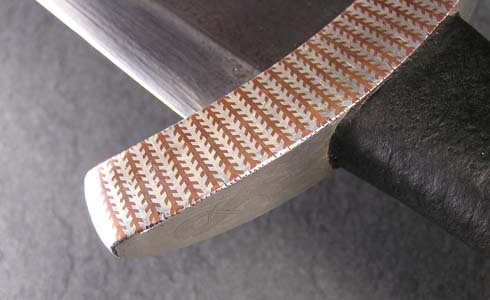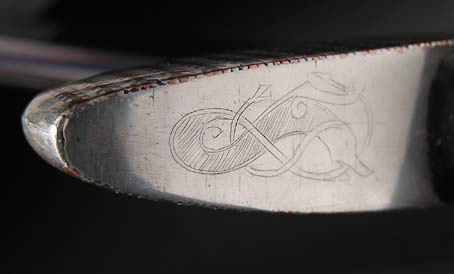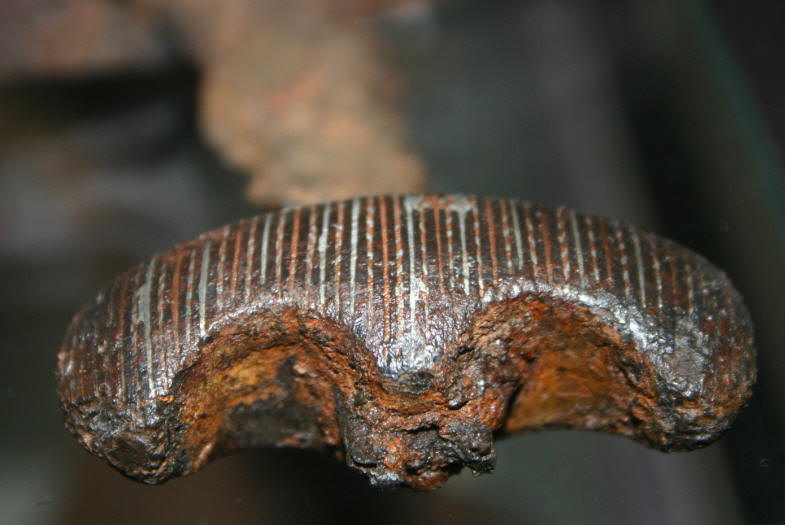Posts: 11,553 Location: San Francisco
Wed 27 Sep, 2006 6:08 pm
| Jeremy V. Krause wrote: |
Jeff,
So what did you inlay in the blade, or am I misunderstanding your initial post. Could you give a close up shot of the blade inlay if there is one. The sword is great!
Thanks,
Jeremy |
Man oh man, this is a fantastic piece of work.
I believe there are photos of the blade in the topic he referenced in the first post.
Regardless, I also would like to request more photos. Closeups of both hilt and blade inlays as well as any additional photos you'd be willing to post.
Posts: 1,082 Location: Finland
Thu 28 Sep, 2006 5:45 am
I'd also be very interested to see more close-ups of the iron inlays on the blade, although I imagine they must be awfully tricky to shoot. The lighting especially would give me sleepless nights a-plenty...
Posts: 145 Location: Oakland, CA
Thu 28 Sep, 2006 7:34 am
Here's the best photo I've been able to get of the inlay, I'll take more close-ups of the hilt soon.
The next blade I do this sort of inlay to will get more tightly twisted wires (for the Nth degreee of authenticity, always twist your damascus tighter ;) ), and less antiquing, it'll show up in photos better then. Direct sunlight and a moving blade are what really show it off, though.
:D A very expensive hedge trimmer? :lol:
[ Linked Image ]
Posts: 1,717 Location: Buffalo, NY.
Thu 28 Sep, 2006 10:53 am
Jeff,
That is spectacular! I thought that you were joking and did that with photoshop in that earlier post! This is great! Absolutely great! I really can't say enough!
I am so excited to see this as my next sword purchase will be a commission featuring iron inlay in the blade- though the letters +INNOMINEDOMINI+ on one side and some simularly lengthy on the other should only be about 1 inch high- to fit into the more narrow and deep fuller of a type XI. I know it will be demanding on the smith. I really feel that this type of inlay is the cutting edge of authentic sword reproduction of the viking and high middle ages. A difference in the inlay of my commission will be that I do not believe that twisted wires were used in the 12th c. Shaftesbury sword but simply iron wires.
Oakeshotts discusses how the seven swords of the GECILINMEFECIT group feature a smaller and neater lettering than the Ulfberts.
Jeremy
Posts: 145 Location: Oakland, CA
Fri 29 Sep, 2006 7:46 am
| Quote: |
| I thought that you were joking and did that with photoshop in that earlier post! |
What, I could have done this all in Photoshop? :D I'll try that on the next one ;)
| Quote: |
| the letters +INNOMINEDOMINI+ on one side and some simularly lengthy on the other |
On your XI commission, if you don't want to say ' X made me' or 'Krause owns me' on the other side, you could just have it say 'in the name of the lord' on both sides - or do you have a phrase picked out already?
Posts: 1,717 Location: Buffalo, NY.
Fri 29 Sep, 2006 3:25 pm
I may have Craig Johnson take the honors and inlay CRAIGMEFECIT. I am not aware of any inlays that I know would be absolutely contemporary with this blade that
Oakeshott dates 1130-1170. I know of swords that are dated to around that period that have variations on +O+or IIIOIII. Maybe IESVSETMARIA but this I have seen inlayed in latten on a 13th c. example.
Speaking of latten inlays in the blade. . . . What do you say Jeff I am sure that brass would look virtually identical?
. ;) :D
Jeremy
Posts: 145 Location: Oakland, CA
Sat 30 Sep, 2006 8:33 am
| Quote: |
| Speaking of latten inlays in the blade. . . . What do you say Jeff I am sure that brass would look virtually identical? |
Since 'latten' is a copper alloy, and some dictionaries define it as 'brass, or an alloy that looks like brass', I'd say virtually identical is an understatement :D
Edit: also see concurrent thread: http://www.myArmoury.com/talk/viewtopic.php?t=7907&start=30
Posts: 1,717 Location: Buffalo, NY.
Sun 01 Oct, 2006 1:42 pm
Jeff,
I am going to keep this thread going as this subject of blade inlay is facinating to me and, in my opinion, under appreciated by the collecting community. Sorry for my minor rant. ;)
So Jeff, or anyone else, do you think that silver inlay or even tin inlay would show up fairly clearly in a finished blade? I believe that these metals would be applied after heat treat. I amso wonder where do smiths come by plain silver. I know that most silver nowadays is sterling which entails some kind of additive which, I think, would look rather different than pure or near pure silver which tarnishes at an increased rate.
I also wonder why we don't see copper inlayed in the blade. I know we see it in hilts but I am not aware of any copper blade inlay.
Jeremy
p.s. Moderators: if this should be split into a different post feel free to do so.
Posts: 145 Location: Oakland, CA
Sun 01 Oct, 2006 4:02 pm
You could start a new thread, 'swords that are
really saying something' ;)
Silver would look good, tin would not hold a polish well. I've seen copper in ethnographic blades from various cultures, and have wondered why galvanic corrosion is not an issue; in a cared-for blade, it would not have a chance to start, but leave the blade in the damp for a short amount of time and you should get some really agressive pitting or worse.
Here's another view of this sword's hilt, feel free to compare it to the hilt in this thread ( Type H with plated hilt
http://www.myArmoury.com/talk/viewtopic.php?t=5386 ) and let me know if it looks close (aside from the obvious slightly larger wire and different pattern, of course):
 Attachment: 27.98 KB
Attachment: 27.98 KB

Posts: 1,717 Location: Buffalo, NY.
Sun 01 Oct, 2006 5:01 pm
Jeff,
lt looks great and completely consistent with this example. The only difference I can see is in the hue of the copper on the historical sword- that may be due to the picture or the effects of time. Are the alternating rows on your sword silver?
Thanks,
Jeremy
Posts: 145 Location: Oakland, CA
Mon 02 Oct, 2006 8:29 am
| Quote: |
| The only difference I can see is in the hue of the copper on the historical sword- |
Oh, that's the other difference - the Type H is 'latten' & silver ('messing' in the German of the conservator's report); this one is copper and silver. The Type H is remarkably well preserved, and well photographed in that thread, that's why I offered it up for comparison. A more direct comparison is the decoration on the hilt of the sword pictured on page 93 of Peirce's "Swords of the Viking Age", another 10th C. sword that was the direct inspiration for the decoration on my piece.
The author states it is decorated with 'plaited' silver and copper. If by 'plaited' he means braided, I'd have to disagree, it seems to be combinations of left and right twists to me.
Posts: 5,739 Location: Wichita, Kansas
Mon 02 Oct, 2006 9:23 am
I think you've captured the overall look of the originals very well. I also like the decoration on the inside of the lower guard, is the upper guard done in the same fashion?
Posts: 145 Location: Oakland, CA
Tue 03 Oct, 2006 6:13 am
Yes, there are Jellinge style beasts on both upper and lower guards, done in a informal, 'viking grafitti' way. I might still rework them into a more 'done at the factory' way, but since the hilt is together, it's too late for niello. The Vikings didn't seem to leave too many surfaces undecorated!
 Attachment: 10.65 KB
Attachment: 10.65 KB

Posts: 1,717 Location: Buffalo, NY.
Tue 03 Oct, 2006 7:02 am
Man Jeff, now you're talking niello! You da man!
Posts: 1,717 Location: Buffalo, NY.
Thu 05 Oct, 2006 12:20 pm
Jeff,
How do you plan to produce the niello? Have you worked with it in the past? How does it behave? Are you aware of any swords of the medieval period using niello or does it seem to be used primarily in the viking period?
Jeremy
Posts: 145 Location: Oakland, CA
Fri 06 Oct, 2006 7:39 am
Jeremy -
I've done niello on silver jewelry before, but not sword parts - I tend to think of niello as something to do to a silver surface, and most of the hilts I do are plain iron. It's been used on swords and scabbards throughout history, I believe, but not everywhere - I don't know of specific medieval examples off hand. It's still being used, as far as I know, in India and the 'stans.
Making it is very alchemical, mixing sulfur into molten lead, copper and silver, lots of toxic fumes :wtf:
It is a pain to use, easy to undercook, overcook, get pits and bubbles- I can't recommend it. :D
I just ran across a photo of a Viking Sword in the Edinburgh Museum, taken by Mr. T McDonald and posted on another forum, that has the same inlay design, silver and copper alternating with left and right twists. Interesting!
Posts: 145 Location: Oakland, CA
Fri 06 Oct, 2006 6:32 pm
The Edinburgh pommel, note the remaining silver between the channel wires in a couple places.
Hope my sword looks this good in a thousand years!
:D
 Attachment: 53.76 KB
Attachment: 53.76 KB

Photo - T. McDonald, 2005
Posts: 820 Location: Texas
Sat 07 Oct, 2006 3:18 pm
Hey Jeff...
Sorry to come in so late...
But that is one fantastic work of art! Your skills astound me. :D
Thanks for letting us take a look.
ks
You
cannot post new topics in this forum
You
cannot reply to topics in this forum
You
cannot edit your posts in this forum
You
cannot delete your posts in this forum
You
cannot vote in polls in this forum
You
cannot attach files in this forum
You
can download files in this forum


